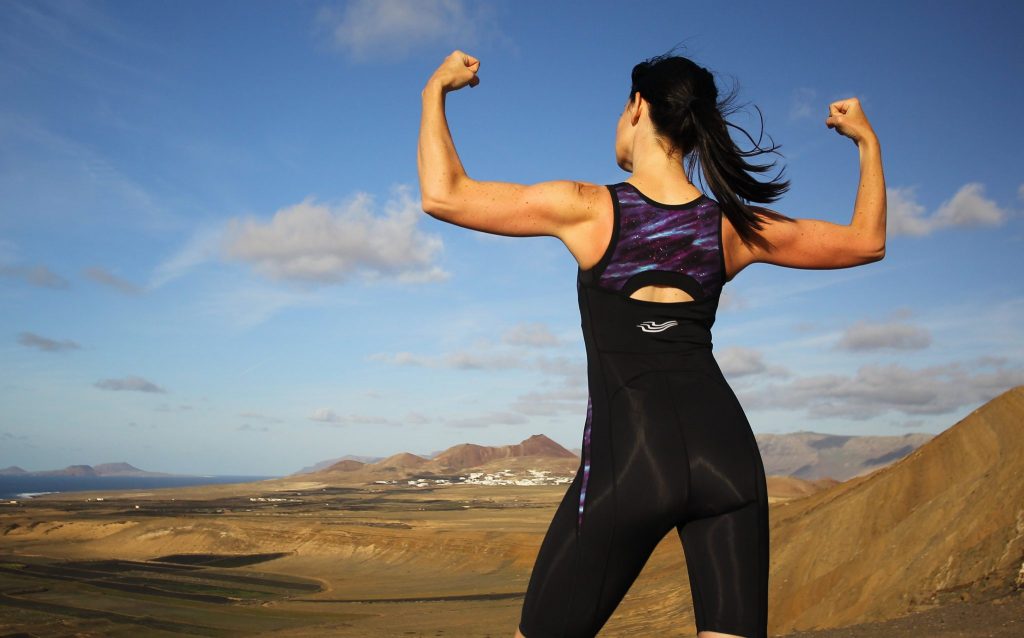Pilates for Triathletes: Finding your Training Power House
Triathlon is a really cool sport. Yes, people swim, bike and run, but put them together and something unique and special is created. It is the diversity that’s amazing- it’s never boring and there is always one area to develop or strengthen.
Triathlon’s training diversity is what attracts so many people to the sport. Unfortunately, it’s also what often puts triathletes at high risk of postural imbalances, muscle strains and over-use injuries.
This is where a fourth discipline, Pilates for triathletes, comes in. Pilates for triathletes is one of the most effective forms of body maintenance and injury avoidance, so why not add Pilates to your training today?
What is Pilates?
Pilates is a form of gentle, non-aerobic exercise, that will strengthen and tone muscles without stressing the joints or the heart. Pilates for triathletes is one of the most effective forms of pre-habilitation (body maintenance and injury avoidance). It can be safely done everyday!
Pilates exercises are aimed at the full body. Every exercise is designed to elongate, strengthen and restore the body to its natural patterns. Programmes gently develop strength and tone in a way which lightens the load on the spine and joints. This helps each facet of the body to function better, to move with greater ease and with better control. Pilates does this by helping to rediscover the body’s natural movements and alignments. This restores balance that is lost with bad posture and misuse of muscles (which can happen during long rides and swims). The result of Pilates for triathletes is strengthening of muscles and freedom of movement with the lovely bi-product of looking taller, leaner and more toned!
The Power House and Core Strength
One of the main areas of focus in Pilates is the ‘Power House’. These are the core muscles and core-stabilising muscles which include the abdominals, pelvic floor, hips, glutes and buttock muscles. A strong power house is vital for triathlon. This set of muscles is the stabiliser of the whole body, transferring force from one extremity to another or initiating the movements themselves. Core strength is also key to reducing the levels of fatigue and helping get through those long rides and runs. (Especially for you, middle and long course superstars!)
Check out a favourite Power House exercise,The Hundred, below.
Staying Flexible and Mobile
A Kyphotic (hunched) posture is adopted on the bike – really not ideal for back health! This posture can cause excessive forward flexion of the lumbar spine, forward rotation of the hips and pelvis. Often there is a shortening of the neck muscles due to looking forward during riding. It is this posture that is a major cause of lower back pain in cyclists. What’s more, shortened hamstrings and neural issues along with ITB/ gluteal/ piriformis injuries are often seen in both cyclists and runners (uh-oh!)
Running is all about economy and efficiency, but when muscles are tight and inflexible, that smooth effortless stride just cannot be reached. More flexibility can help to improve stride length, potentially giving the ability to run faster and for longer! Flexibility + strength is the injury-preventing combo that Pilates provides. The Pilates approach works to improve flexibility, but focuses on stabilisers, supporting minor muscle groups and consolidating imbalances alongside it.
Added bonus? Pilates can make you quicker, too!
Check out a favourite stretching and strengthening exercise, Front and Back Side Kicks, below.
A Breath of Fresh Air in a Crazy World
Life can be crazy, especially for a triathlete-in-training. Pilates is known to give you a sense of optimal well-being by joining together mind and body. The smooth, steady movements help to quieten your mind and soothe the nervous system. As muscles are lengthened and strengthened, circulation is improved and tension released. Just 20-30 minutes of Pilates allows for a feeling of calm, balance, and rejuvenation.
Check out a favourite body awareness exercise, The Roll Down, below.
All-in-all, Pilates for triathletes could help you find a healthier, happier, stronger and faster you!
Here are 3 simple exercises to fit in to your daily routine. All it takes is 5-10 quick minutes of mindful motions, and a whole world of benefits could be coming your way.
1. The Hundreds
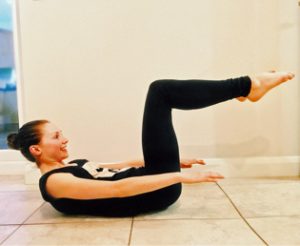 Set up:
Set up:
• Lie flat on your back with legs bent into a tabletop position (i.e., knees over hips, shins parallel to the floor, and arms long by your sides).
• Keep your tummy flat and drawn in (think belly button to spine) and flatten your lower back onto the mat/ floor.
Action:
• Breathe in to prepare, and as you breathe out, curl your head and chest up and hover with your arms about two inches above the mat.
• Begin to pump the arms up and down (2-3 inches).
• Inhale for 5 counts. Exhale for 5 counts.
• Continue the inhale/ exhale combination for 10 sets.
• Use your breath to coordinate the motion and keep the stomach flat and pulled in at all time.
Tips:
– If holding your head up strains the neck try one of the following. Keep your head flat, supported with one hand placed behind the neck whilst the other arm does the pumping. Alternatively place a rolled up towel underneath your head for support.
– Focus on drawing the abdominal muscles in and up along the spine to keep the movement controlled and out of the lower back. Make sure that the lower back doesn’t pop off the floor. If it does so, pause the exercise, reset and begin again.
This is a fantastic way to strengthen the core muscles, warm up the body, and even stimulate circulation.
Variations:
To make this move more challenging, extend the legs out to a longer angle. (But double check that abdominals are deeply scooped in and active throughout!).
To make it easier, place the feet on the floor and just use the arms motion.
2. Front and Back Side Kicks
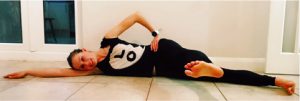 Set up:
Set up:
• Lie on your side stacking shoulders and hips aligned.
• Keeping your torso straight along the back of the mat, take your legs on the diagonal to the front corner of the mat so you are in a ‘pike’ position to help balance.
• Rest your head on your bottom arm and place your top hand on the mat, in front of your stomach for support.
• Make sure you are not rolling forwards or backwards, but the body is stacked and in one long line.
• Draw the abdominals in and engage the glutes.
Action:
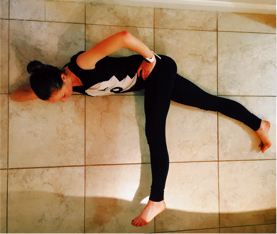 • Raise your top leg to hip level.
• Raise your top leg to hip level.
• Keeping your torso still, flex the foot and kick your leg forwards with a little pulse “one-two” as your leg comes in line with your hips. Point the toe and swing the leg backwards about half a foot behind the hips.
• Inhale and flex your foot as you swing your leg forward; exhale as you point your foot and swing your leg back.
• Repeat 6-8 times and then switch sides.
• The goal is not to wobble, fall forwards or back or go out of alignment. Make sure you are engaging the abdominals throughout and ensure the motion is not too large or forceful. Quality over quantity!
Tips:
– Focus on length through the leg and torso.
– The body stays still throughout- just the leg moves from the hips.
– Think of a pendulum swinging from a solid, stable middle.
– The muscles at your waist stay tight.
– You should feel a nice pull in your hamstrings as you kick forwards and a gentle stretch of the hip flexors as you go backwards.
This is also a lovely smooth motion and should be flowing without pausing throughout.
Variations:
Bend your bottom leg up towards your hips for extra stability if you are rolling around a lot.
To make it harder, reach the top arm up towards the ceiling to reduce the base of support.
3. The Roll Down
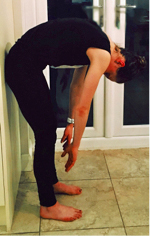 Set up:
Set up:
• Stand tall with your back against a wall.
• Think long and tall- imagine that there is a string coming from the crown of your head and reaching you up towards the ceiling.
• Soften the rib cage so the chest is not flaring.
• Draw your shoulders down and away from your ears and relax your arms by your sides
• Have a soft bend in your knees and make sure knees are tracking directly over your ankles.
Action:
• Arms stay parallel as you nod your head and begin to slowly roll your spine down and away from the wall, vertebrae by vertebrae.
• Keep your abdominals pulled in and lifted (belly button towards spine) and feel a sense of lengthening of the spine as you roll.
• As the roll progresses, deepen the abdominal curl even more and start to walk your fingers down your legs towards the floor.
• Keep the head and neck relaxed throughout.
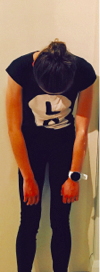 • Roll down as far as you can go without letting your hips leave the wall. Hold in the deepest part of the curve and gently rotate the head and spine left to right to enjoy a good hamstring stretch.
• Roll down as far as you can go without letting your hips leave the wall. Hold in the deepest part of the curve and gently rotate the head and spine left to right to enjoy a good hamstring stretch.
• For the return, the dynamic changes. You imagine being punched in the stomach as you strongly engage the stomach muscles and use the stomach engagement to initiate the roll up from your lower abdominals.
• Continue the roll up by replacing each vertebrae back onto the wall, one by one. As your roll up, the arms travel along the ears and shoulder, head and neck are relaxed.
• The head is the last thing to come up and the shoulders roll back and down away from the ears, ready to go again.
• Repeat 4-6 times.
Tips
– The focus here is sequential mobilisation of the spine, but you want the roll down motion to be smooth and not jerky.
– You may not be able to get very far at first, and it is important only to go as far as is comfortable. The hamstring stretch should feel like a gentle pull, but not painful.
Variations
Try the roll down to one side so the arms walk down the right leg and the body follows on the diagonal and in the same process as above. Then switch sides. This is a nice way to gently stretch out the back and relieve tightnesses after a hard day’s work at a desk or a long ride!
